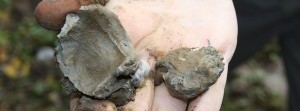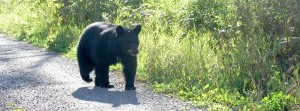
Photo Credit: Norma Kerby
Peaveys, Pickaxes & other Perfect-for-the-Job Implements: Nostalgia for heritage gardening equipment
With amazing vigour, the rootstock for my Montmorency pie cherry sent suckers across the yard into the garden. Within three years, the neglected corner by the turkey shed supports a healthy grove of pin-cherry trees that are sending their own suckers into the dahlia patch.
“Well, this is going to be a problem,” I say to my garden helper about the trees too close to the shed for a chainsaw and too thoroughly rooted in the ground to use a handsaw. Finding a tool to cut out the stumps and roots, other than an expensive backhoe, was going to be a challenge. I live in the part of northern BC where any piece of land left unattended rapidly grows up in shrubs and trees: more often than not red alder, but in this case the aggressive offspring of a happy fruit tree.
Tree growth is a constant struggle in this climate, but a minor problem today compared to what the first round of farmers who cleared the giants of the inland rainforests had to face. Fighting their way through monstrous stumps and massive roots, these old-timers used methods for land-clearing that were simple: dynamite, fire, horse teams and a raft of hand tools, each adapted to specific uses in their efforts to farm the soil.
Tool for the job
I have long been fascinated by old tools. The genius of adaptation to different gardening and farming tasks has left an intriguing legacy of hand equipment from the early to mid-1900s, when farming and home gardens were vital to northern communities. With smooth hardwood handles and indestructible iron blades, these tools fit many modern needs of a serious gardener or rural property owner.
Old tools are not easy to find. Most gardeners I know who use them have either inherited them or found them sporadically in second-hand stores or garage sales. Estate sales are another potential source of quality antique or vintage hand tools. Beware, though, of cracked handles and loose-fitting or broken iron heads. Having a tool come apart when you are undertaking a strenuous task can be quite dangerous.
It is very important to look after heritage tools, as they can deteriorate in wet conditions. Wood and iron tools should be put away clean and dry for the winter, such as on the wall of a shed or garage. To prolong their lives further, keep them clean and out of rain and intense sunlight during the growing season. Many people oil the handles and blades, but the necessity of this depends on the local climate.
It is the range of old tools that is so useful to the gardener or rural dweller. Shovels are a good example. A hundred years ago, muscle power was the primary mechanism for doing work. By designing shovels for specific tasks, the amount of work was greatly reduced and efficiency significantly increased.
In the collection of old shovels in my shed, many were inherited from my father. There is a straight-bottom, flat-grain shovel for loose material that did not need to be pried. Next to it is a narrow, sharp shovel for cutting sod. The next two shovels have different widths and depths for moving heavier materials such as gravel or sand, followed by two shovels, also of different widths and depths, for digging garden soil. A smaller shovel with a D-style handle sits adjacent to a sharp-bladed shovel with a very long handle, good for levering soil out of a deeper hole. In the old days, all these shovels would have hung between slats in the barn, ready for specific jobs.
Garden shovels have never gone out of fashion, but a check online at a major hardware store shows a list of only six varieties, five of which have the same size cutting blade but with variations in handle lengths and styles. The large, historic variation in gardening shovels has, for the most part, disappeared from commercial sales.
A spate of rakes
Historical rakes in my shed include a number of bow rakes and flat rakes of various tooth lengths and widths. These tough rakes are suitable for spreading gravel or raking roots, branches and soil clods. The less robust leaf rakes, artistic with their fans of flat metal prongs, have not fared as well and sport missing teeth, but are still efficient at piling up leaves or grass without tearing up the sod. The most unusual rakes are the two burning-pile fire rakes that my father welded—bow rake and flat rake bottoms on metal pipes, as the hardwood handles of normal rakes could catch fire when rearranging burning logs.
Heritage rakes were built for hard work. Compared to the plastic rakes available at most supply stores, they are far less likely to break during serious raking jobs.
Rakes and shovels are still in fashion for gardening and farming, but a variety of other antique tools disappeared from common use as most of our food-growing activities were mechanized. Amongst these tools were the forged tools, often made by the town blacksmith, such as pokes, hooks and grapples for moving fence posts and logs. Some of these forged tools’ original uses I have collected remain a mystery, but all are put to use in tackling objects too heavy to lift. Leverage combined with metal grapples, or a sturdy hardwood-handled peavey, can manoeuvre large poles that could never be moved by hand.
Other useful heritage tools for the home gardener not commonly considered include mattocks and pickaxes. Although you can buy modern mattocks with fibreglass handles, I prefer the more robust historic ones. Mattocks have an axe or sledge on one side of the head, with an adze on the other side. My two historic mattocks have adzes of different sizes, perfect for slicing through roots of variable diameters around stubborn stumps.
Pickaxes were the domain of the early-day hand-miners. If you are gardening where the soil is inclined to form hardpan, or where shovel work cannot break through an impermeable layer, a pickaxe will break up the material. Both tools are well suited for use in small spaces or areas inaccessible to mechanized equipment.
With proper care, all the heritage tools at our place should last a few more generations. In the battle with the sprouts from my pie cherry, especially those that sneakily grow next to the walls of my sheds, the flexibility of these old tools is always appreciated. As long as my aim is good, with a combination of mattocks and sharp shovels, any number of trees can be removed from even the most awkward of locations.





